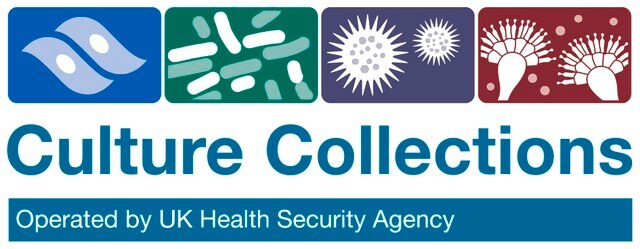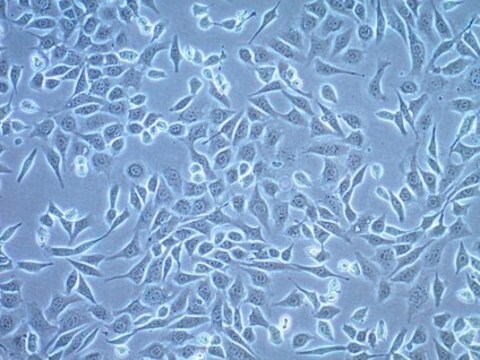SCC420
B16-OVA MO4 Mouse Melanoma Cell Line
Mouse
Synonim(y):
B16-OVA MO4 Cell Line, Melanoma Cell Line, Mouse Melanoma Cells
Zaloguj sięWyświetlanie cen organizacyjnych i kontraktowych
About This Item
Kod UNSPSC:
41106514
NACRES:
NA.71
Polecane produkty
Nazwa produktu
B16-OVA MO4 Mouse Melanoma Cell Line,
pochodzenie biologiczne
mouse
opakowanie
vial of >1X10⁶ cells
producent / nazwa handlowa
Millipore
tryb wzrostu
N/A
metody
cell culture | mammalian: suitable
Warunki transportu
dry ice
temp. przechowywania
−196°C
Opis ogólny
The immune system can recognize and destroy tumors. Cytotoxic T lymphocytes (CTLs) kill neoplastic (or virally infected) cells after recognizing antigenic peptides bound to major histocompatibility complex (MHC) class I molecules on their surface. These peptides are derived from antigens that are degraded in the cytosol of the affected cell. Immunizations with killedpathogens or their proteins do not generally elicit CTLs, because exogenous proteins cannot enter the cytosol (to bepresented). However, antigens that are internalized into phagocytic cells can enter the cytosol and be processed for classI presentation. Immunization with a purified antigen attached to an avidly phagocytized particle primes CTLs, which in turnprotect animals from subsequent challenge with tumors transfected with the antigen gene.
Zastosowanie
- Each vial contains >1X106 viable cells.
- Cells are tested negative for infectious diseases by a Mouse Essential CLEAR panel by Charles River Animal Diagnostic Services.
Cells are verified to be of mouse origin and negative for inter-species contamination from rat, Chinese hamster, Golden Syrian hamster, human and non-human primate (NHP) as assessed by a Contamination CLEAR panel by Charles River Animal Diagnostic Services.
- Cells are negative for mycoplasma contamination.
Background
The immune system can recognize and destroy tumors. Cytotoxic T lymphocytes (CTLs) kill neoplastic or virally infected cells after recognizing antigenic peptides bound to major histocompatibility complex class I molecules on their surface. These peptides are derived from antigens that are degraded in the cytosol of the affected cell. Immunizations with killed pathogens or their proteins do not generally elicit CTLs, because exogenous proteins cannot enter the cytosol (to be presented). However, antigens that are internalized into phagocytic cells can enter the cytosol and be processed for class I presentation. Immunization with a purified antigen attached to an avidly phagocytized particle primes CTLs, which in turn protect animals from subsequent challenge with tumors transfected with the antigen gene.1
Source
Tumor rejection antigens – TRAs – differ from any other protein synthesized by the cell in that the host is intolerant to them. Thus virtually any foreign protein synthesized by a tumor, including those expressed from foreign antigen genes transfected into tumor cells, should function and behave like TRAs. This hypothesis was tested in a murine tumor model developed by transfecting the chicken ovalbumin gene into the C57BL/6 (H-2b haplotype)-derived murine melanoma cell line B16, followed by selection and isolation of the ovalbumin (OVA)-transfected B16 clone B16-OVA MO4.1
In in vitro challenge, B16-OVA MO4 cells stimulated the OVA+ Kb-specific T-cell hybridoma RF33.70 to produce interleukin-2 whereas untransfected B16 cells did not. Injected intradermally into syngeneic C57Bl/6 mice, both B16 and B16-OVA MO4 grew progressively, metastasized, and killed the animals showing that expression of the ovalbumin antigen alone does not render this tumor sufficiently immunogenic to be rejected. Subcutaneous immunization of C57Bl/6 mice with ovalbumin conjugated to iron beads (OVA-Fe), however, protected B16-OVA MO4 (but not B16) challenged animals both from local tumor growth and death. This approach could be exploited to develop tumor and viral vaccines.1
References
1. Falo LD Jr, Kovacsovics-Bankowski M, Thompson K, Rock KL. Nat. Med. 1995; 1(7):649-653.
2. Fidler IJ. Cancer Res. 1975; 35(1):218-224.
Note: Mouse xenotropic retrovirus Bxv-1 proviral DNA is detected in B16-OVA MO4 cells, BXV-1 is a Biosafety Level 2 (BSL-2) pathogen.
The immune system can recognize and destroy tumors. Cytotoxic T lymphocytes (CTLs) kill neoplastic or virally infected cells after recognizing antigenic peptides bound to major histocompatibility complex class I molecules on their surface. These peptides are derived from antigens that are degraded in the cytosol of the affected cell. Immunizations with killed pathogens or their proteins do not generally elicit CTLs, because exogenous proteins cannot enter the cytosol (to be presented). However, antigens that are internalized into phagocytic cells can enter the cytosol and be processed for class I presentation. Immunization with a purified antigen attached to an avidly phagocytized particle primes CTLs, which in turn protect animals from subsequent challenge with tumors transfected with the antigen gene.1
Source
Tumor rejection antigens – TRAs – differ from any other protein synthesized by the cell in that the host is intolerant to them. Thus virtually any foreign protein synthesized by a tumor, including those expressed from foreign antigen genes transfected into tumor cells, should function and behave like TRAs. This hypothesis was tested in a murine tumor model developed by transfecting the chicken ovalbumin gene into the C57BL/6 (H-2b haplotype)-derived murine melanoma cell line B16, followed by selection and isolation of the ovalbumin (OVA)-transfected B16 clone B16-OVA MO4.1
In in vitro challenge, B16-OVA MO4 cells stimulated the OVA+ Kb-specific T-cell hybridoma RF33.70 to produce interleukin-2 whereas untransfected B16 cells did not. Injected intradermally into syngeneic C57Bl/6 mice, both B16 and B16-OVA MO4 grew progressively, metastasized, and killed the animals showing that expression of the ovalbumin antigen alone does not render this tumor sufficiently immunogenic to be rejected. Subcutaneous immunization of C57Bl/6 mice with ovalbumin conjugated to iron beads (OVA-Fe), however, protected B16-OVA MO4 (but not B16) challenged animals both from local tumor growth and death. This approach could be exploited to develop tumor and viral vaccines.1
References
1. Falo LD Jr, Kovacsovics-Bankowski M, Thompson K, Rock KL. Nat. Med. 1995; 1(7):649-653.
2. Fidler IJ. Cancer Res. 1975; 35(1):218-224.
Note: Mouse xenotropic retrovirus Bxv-1 proviral DNA is detected in B16-OVA MO4 cells, BXV-1 is a Biosafety Level 2 (BSL-2) pathogen.
Cechy i korzyści
B16-OVA MO4 cell line is a model for cancer immunotherapy, expressing ovalbumin (OVA) in order to facilitate strong immune responses to tumor antigens.
Przechowywanie i stabilność
Cells should be stored in liquid nitrogen until use. The cells can be cultured for at least 10 passages after initial thawing without significantly affecting the cell marker expression and functionality.
Inne uwagi
This product is intended for sale and sold solely to academic institutions for internal academic research use per the terms of the “Academic Use Agreement” as detailed in the product documentation.
Oświadczenie o zrzeczeniu się odpowiedzialności
Unless otherwise stated in our catalog or other company documentation accompanying the product(s), our products are intended for research use only and are not to be used for any other purpose, which includes but is not limited to, unauthorized commercial uses, in vitro diagnostic uses, ex vivo or in vivo therapeutic uses or any type of consumption or application to humans or animals.
Ta strona może zawierać tekst przetłumaczony maszynowo.
Kod klasy składowania
10 - Combustible liquids
Klasa zagrożenia wodnego (WGK)
WGK 2
Temperatura zapłonu (°F)
Not applicable
Temperatura zapłonu (°C)
Not applicable
Certyfikaty analizy (CoA)
Poszukaj Certyfikaty analizy (CoA), wpisując numer partii/serii produktów. Numery serii i partii można znaleźć na etykiecie produktu po słowach „seria” lub „partia”.
Masz już ten produkt?
Dokumenty związane z niedawno zakupionymi produktami zostały zamieszczone w Bibliotece dokumentów.
Nasz zespół naukowców ma doświadczenie we wszystkich obszarach badań, w tym w naukach przyrodniczych, materiałoznawstwie, syntezie chemicznej, chromatografii, analityce i wielu innych dziedzinach.
Skontaktuj się z zespołem ds. pomocy technicznej







